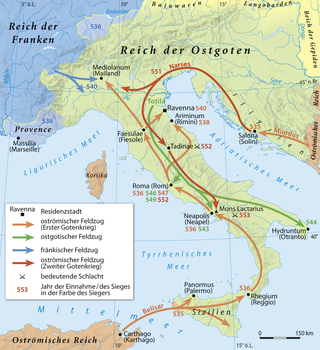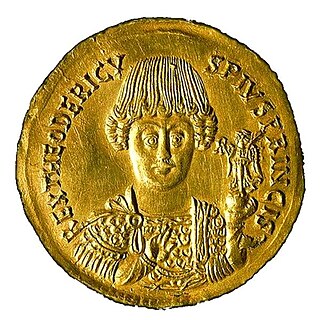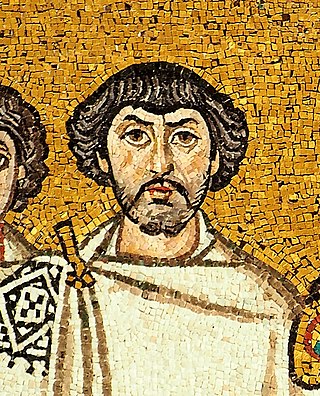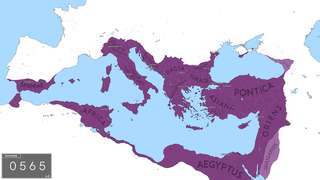
Justinian I, also known as Justinian the Great, was the Roman emperor from 527 to 565.
Pope Silverius was bishop of Rome from 8 June 536 to his deposition in 537, a few months before his death. His rapid rise to prominence from a deacon to the papacy coincided with the efforts of Ostrogothic king Theodahad, who intended to install a pro-Gothic candidate just before the Gothic War. Later deposed by Byzantine general Belisarius, he was tried and sent to exile on the desolated island of Palmarola, where he starved to death in 537.
The 530s decade ran from January 1, 530, to December 31, 539.
The 540s decade ran from January 1, 540, to December 31, 549.
Year 536 was a leap year starting on Tuesday of the Julian calendar. At the time, it was known as the Year after the Consulship of Belisarius.
Year 538 (DXXXVIII) was a common year starting on Friday of the Julian calendar. At the time, it was known as the Year of the Consulship of Iohannes without colleague. The denomination 538 for this year has been used since the early medieval period, when the Anno Domini calendar era became the prevalent method in Europe for naming years.

Narses was, with Belisarius, one of the great generals in the service of the Byzantine Emperor Justinian I during the Roman reconquest that took place during Justinian's reign. Narses was a Romanized Armenian. He spent most of his life as an important eunuch in the palace of the emperors in Constantinople.
Pope Vigilius was the bishop of Rome from 29 March 537 to his death. He is considered the first pope of the Byzantine papacy. Born into Roman aristocracy, Vigilius served as a deacon and papal apocrisiarius in Constantinople. He allied with Empress Theodora, who sought his help to establish Monophysitism, and was made pope after the deposition of Silverius. After he refused to sign Emperor Justinian I's edict condemning the Three Chapters, Vigilius was arrested in 545 and taken to Constantinople. He died in Sicily while returning to Rome.

Totila, original name Baduila, was the penultimate King of the Ostrogoths, reigning from 541 to 552 AD. A skilled military and political leader, Totila reversed the tide of the Gothic War, recovering by 543 almost all the territories in Italy that the Eastern Roman Empire had captured from his Kingdom in 540.

The Gothic War between the Byzantine Empire during the reign of Emperor Justinian I and the Ostrogothic Kingdom of Italy took place from 535 to 554 in the Italian peninsula, Dalmatia, Sardinia, Sicily, and Corsica. It was one of the last of the many Gothic wars against the Roman Empire. The war had its roots in the ambition of the Byzantine emperor Justinian I to recover the provinces of the former Western Roman Empire, which the Romans had lost to invading barbarian tribes in the previous century, during the Migration Period.

The Ostrogothic Kingdom, officially the Kingdom of Italy, was a barbarian kingdom established by the Germanic Ostrogoths that controlled Italy and neighbouring areas between 493 and 553. Led by Theodoric the Great, the Ostrogoths killed Odoacer, a Germanic soldier and erstwhile leader of the foederati. Odoacer had previously become the de facto ruler of Italy following his deposition of Romulus Augustulus, the final emperor of the Western Roman Empire, in 476. Under Theodoric, the Ostrogothic kingdom reached its zenith, stretching from modern Southern France in the west to the modern western Serbia in the southeast. Most of the social institutions of the late Western Roman Empire were preserved during his rule. Theodoric called himself Gothorum Romanorumque rex 'King of the Goths and Romans', demonstrating his desire to be a leader for both peoples.
The First Siege of Rome during the Gothic War lasted for a year and nine days, from 2 March 537 to 12 March 538. The city was besieged by the Ostrogothic army under their king Vitiges; the defending East Romans were commanded by Belisarius, one of the most famous and successful Roman generals. The siege was the first major encounter between the forces of the two opponents, and played a decisive role in the subsequent development of the war.

The Battle of Sena Gallica was a naval battle fought off the Italian Adriatic coast in the autumn of 551 between an East Roman (Byzantine) and an Ostrogoth fleet, during the Gothic War (535–554). It marked the end of the Goths' brief bid to deny the seas to the Romans, and the beginning of the Byzantine resurgence in the war under the leadership of Narses.

Belisarius was a military commander of the Byzantine Empire under Emperor Justinian I. Belisarius was instrumental in the reconquest of much of the Mediterranean territory belonging to the former Western Roman Empire, which had been lost less than a century prior. He is considered one of the greatest military commanders in history and the greatest of all Byzantine generals.

The Byzantine Empire underwent a golden age under the Justinian dynasty, beginning in 518 AD with the accession of Justin I. Under the Justinian dynasty, particularly the reign of Justinian I, the empire reached its greatest territorial extent since the fall of its Western counterpart, reincorporating North Africa, southern Illyria, southern Spain, and Italy into the empire. The Justinian dynasty ended in 602 with the deposition of Maurice and the ascension of his successor, Phocas.

Antonina was a Byzantine patrician and wife of the general Belisarius.

John, also known as John the Sanguinary, was the nephew of the rebel Vitalian and was an Eastern Roman general under Justinian I, who was active in the Gothic War in Italy and against the Gepids in the western Balkans. He was married to Justina, the daughter of Justinian's cousin Germanus.
Bessas was an Eastern Roman general of Gothic origin from Thrace, primarily known for his career in the wars of Justinian I. He distinguished himself against the Sassanid Persians in the Iberian War and under the command of Belisarius in the Gothic War, but after Belisarius' departure from Italy he failed to confront the resurgent Goths and was largely responsible for the loss of Rome in 546. Returning east in disgrace, despite his advanced age he was appointed as commander in the Lazic War. There he redeemed himself with the recapture of Petra, but his subsequent idleness led Justinian to dismiss him and exile him to Abasgia.
The siege of Ariminum, also known as the siege of Rimini, was an encounter in the Gothic War between Byzantine forces under Belisarius and John and an Ostrogothic force in 538 AD.

Mauricius was a Gepid general fighting for the Byzantine Empire. He was the son of Magister militium Mundus. He was presumably an MVM vacans.












